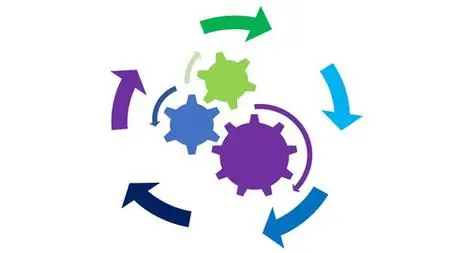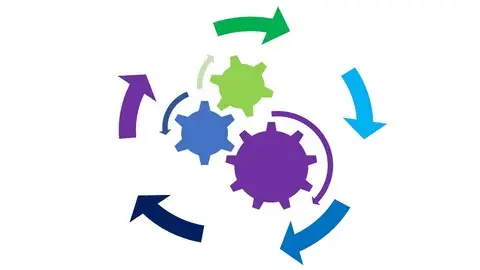Agile Bm 101 Introduction To Agile Business Management
Last updated 11/2020
MP4 | Video: h264, 1280x720 | Audio: AAC, 44.1 KHz
Language: English | Size: 404.24 MB | Duration: 2h 0m
Last updated 11/2020
MP4 | Video: h264, 1280x720 | Audio: AAC, 44.1 KHz
Language: English | Size: 404.24 MB | Duration: 2h 0m
Learn how to blend Agile and traditional plan-driven project management to get the best of both worlds!
What you'll learn
How to blend Agile and traditional plan-driven project management in the right proportions to fit any situation
Requirements
Some familiarity with project management is helpful but not required
Description
Course Statistics:Over 125,000 students in my courses!Over 7,000 5-star reviews in my courses!Earn PDU's: Students who complete this course are eligible to receive 2.0 PDU's in PMI continuing education credits. Instructions for claiming PDU's are provided with the last lesson in the course.Money-back Guaranty: Try this course and if you are not satisfied with the value you received from the course, just send an email to Udemy support and they will give you a 100% refund within 30 days.____________________________________________________________________________Course Summary:1. Learn to See Agile and Waterfall in a fresh new perspecttve as complementary to each other rather than competitiveMany businesses and project managers are faced with a choice of choosing a traditional plan-driven approach (or what is sometimes called “Waterfall") or a more Agile approach for critical projects which can be a very important decision with significant business impact. However, there are many stereotypes and misconceptions that exist about both “Agile" and “Waterfall" that can be very confusing and misleading. As an example, many people see this as a binary and mutually-exclusive choice between two extremes and attempt to force-fit projects to one of these two approaches when the right solution is to go in the other direction and fit the approach to the project.Since this is such a critical decision that has such a big impact, it's very important to get past these stereotypes and misconceptions and:Develop a clear objective understanding of what it means (or doesn't mean) when people talk about "Agile versus Waterfall".See these two approaches in a fresh new perspective as complementary to each other rather than competitive2. Learn how to blend the two approaches in the right proportions to fit any given situation to get the best of both worldsRather than force-fitting a project to one of these extremes, a much better approach is to fit the methodology to the nature of the project. Sometimes that requires blending the two approaches together in the right proportions to fit the situation to get the best of both worlds. It takes more skill to do that but it definitely can be done.____________________________________________________________________________Overall Agile Business Management Curriculum:This course is part of an overall curriculum designed for business people to effectively participate and lead in an Agile environment. Agile significantly changes the role of business people in leading and managing projects and requires a much more active business leadership role to guide the direction of projects that are in progress. The overall curriculum consists of three primary courses:1. Agile BM 101 - Introduction to Agile Business Management (this course)This course povides a solid foundation for the other courses in this overall curriculum and helps all business personnel develop a solid understanding of how to implement a hybrid approach that blends the two approaches in the right proportions to fit any given situation2. Agile BM 201 - Mastering Agile Business ManagementThis course is designed to provide a much deeper understanding of how to effectively lead Agile/Scrum projects for anyone in a Product Owner role or in an equivalent level of business responsibility. The Product Owner role in Agile is not well understood and many business managers who are assigned to perform that role are not well-prepared for it.3. Agile BM 301 - Enterprise-level Agile Business ManagementThe final course in this series is focused on advanced topics related to applying Agile to a business at an enterprise level includingAlignment and Value DisciplinesEnterprise-level frameworks (SAFe and DAD)Enterprise-level Agile TransformationsOrganizational Culture and Change Management____________________________________________________________________________Why Is This Curriculum Important?In a traditional, plan-driven project management environment,A large part of the management of a project can be delegated to a project manager, andOnce the business requirements for the project are documented and approved by the business, the business role in providing leadership and management of the project can be limited.In an Agile environment,The requirements and the design of the solution evolve and are further refined as the project progressesFor that reason, it is essential that the business is much more directly involved in providing leadership and direction to the project as it progressesIn order to provide effective leadership and direction to projects, the business people who are either directly or indirectly involved in Agile projects need to fully understand how the process works in order to participate collaboratively in the process with the project teams who are responsible for developing the solution.Many existing courses for business people in an Agile environment such as Certified Scrum Product Owner (CSPO) are limited to the "mechanics" of how to do Agile and are limited to a pure Agile approach. This course goes into much more depth to give business people a very solid and deeper understanding of both Agile/Scrum as well as traditional plan-driven project management and how to successfully apply it in a business environment.____________________________________________________________________________Important Note: This course is a condensed version of some of the material in our 7-course curriculum for Agile Project Managers and there is no need for anyone to take both sets of courses.
Overview
Section 1: Introduction
Lecture 1 Introduction
Section 2: Agile Versus Waterfall
Lecture 2 What Is Waterfall?
Lecture 3 What Is Agile?
Lecture 4 Agile History
Lecture 5 Choosing the Right Approach
Lecture 6 Agile Versus Waterfall Summary
Section 3: Scrum
Lecture 7 What Is Scrum?
Lecture 8 How Does Scrum Work?
Lecture 9 Scrum Roles
Lecture 10 Scrum Methodology
Lecture 11 Scrum Values
Section 4: Comparison of Agile and Traditional Plan-driven Methodologies
Lecture 12 Empirical versus Defined Processes
Lecture 13 Management of Uncertainty
Lecture 14 Iron Triangle and Agile Triangle
Section 5: Hybrid Agile Models
Lecture 15 How Does a Hybrid Agile Process Work?
Lecture 16 What is a Hybrid Agile Model and Why Would You Use It?
Lecture 17 What Are the Benefits of a Hybrid Agile Model?
Lecture 18 Choosing the Right Approach
Section 6: Hybrid Agile Process Examples
Lecture 19 Managed Agile Development Process Overview
Lecture 20 Managed Agile Development Planning Levels
Lecture 21 Real World Examples
Section 7: Overall Course Summary
Lecture 22 Overall Course Summary
Lecture 23 How to Claim PDUs
Agile Product Owners or Product Managers who need to better understand how to effectively perform the Agile Product Owner role. The Product Owner role in Agile is not well-understood and most of the people who might be selected to perform that role are not well-prepared for what it requires,Business Analysts who work in an Agile environment and need to optimize their skills to provide a high level of value in that environment,Business Sponsors who want to learn more about Agile Project Management in order to provide more effective leadership for the initiatives that they are responsible for,Senior-level Executives who are interested in making their business more agile and want to develop a well-integrated approach to fit an Agile development process to their business



